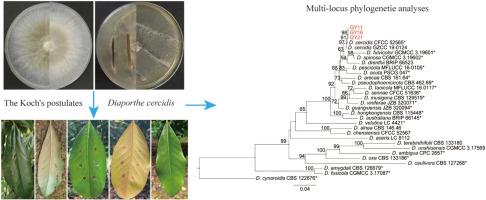引起广玉兰叶枯病的菊蚜
IF 2.5
2区 农林科学
Q1 AGRONOMY
引用次数: 0
摘要
摘要广玉兰是木兰科的一种全球性观赏植物,近年来受到一种新型叶枯病的威胁。2024年6月,我们在江西南昌市的桔梗树上发现了严重的疾病进展,采样标本的发病率为100%。为了澄清疾病的原因,科赫的假设是通过从病理组织中分离真菌菌株,通过人工破坏叶片进行致病性测试,并重新分离来完成的。根据分生孢子形态和ITS(内部转录间隔物)、β-微管蛋白(β-微管蛋白)和TEF(翻译伸长因子1-α)序列的多位点系统发育重建,鉴定该病原菌为cercidis。本研究首次确定了cercidis是世界范围内桔梗叶枯病病原的确切证据。我们的发现扩大了已知的Diaporthe物种的宿主范围,并为在城市景观系统中制定有针对性的管理策略提供了关键的基线数据。本文章由计算机程序翻译,如有差异,请以英文原文为准。

Diaporthe cercidis causing leaf blight on Magnolia grandiflora in China
Magnolia grandiflora (Southern magnolia), a globally cultivated ornamental species in the Magnoliaceae family, has recently been threatened by an emerging leaf blight disease. In June 2024, we observed severe disease progression on M. grandiflora trees in Nanchang, Jiangxi Province, with 100 % incidence rate in sampled specimens. In order to clarify the cause of the disease, Koch's postulates were completed by isolation of fungal strains from pathological tissues, pathogenicity tests performed by artificially damaging leaves, and re-isolation. The pathogen was characterized as Diaporthe cercidis based on conidial morphology and multi-locus phylogenetic reconstruction incorporating ITS (internal transcribed spacer), TUB (β-tubulin), and TEF (translation elongation factor 1-α) sequences. This study establishes the first definitive evidence of D. cercidis as an etiological agent of M. grandiflora leaf blight worldwide. Our findings expand the known host range of Diaporthe species and provide critical baseline data for developing targeted management strategies in urban landscaping systems.
求助全文
通过发布文献求助,成功后即可免费获取论文全文。
去求助
来源期刊

Crop Protection
农林科学-农艺学
CiteScore
6.10
自引率
3.60%
发文量
200
审稿时长
29 days
期刊介绍:
The Editors of Crop Protection especially welcome papers describing an interdisciplinary approach showing how different control strategies can be integrated into practical pest management programs, covering high and low input agricultural systems worldwide. Crop Protection particularly emphasizes the practical aspects of control in the field and for protected crops, and includes work which may lead in the near future to more effective control. The journal does not duplicate the many existing excellent biological science journals, which deal mainly with the more fundamental aspects of plant pathology, applied zoology and weed science. Crop Protection covers all practical aspects of pest, disease and weed control, including the following topics:
-Abiotic damage-
Agronomic control methods-
Assessment of pest and disease damage-
Molecular methods for the detection and assessment of pests and diseases-
Biological control-
Biorational pesticides-
Control of animal pests of world crops-
Control of diseases of crop plants caused by microorganisms-
Control of weeds and integrated management-
Economic considerations-
Effects of plant growth regulators-
Environmental benefits of reduced pesticide use-
Environmental effects of pesticides-
Epidemiology of pests and diseases in relation to control-
GM Crops, and genetic engineering applications-
Importance and control of postharvest crop losses-
Integrated control-
Interrelationships and compatibility among different control strategies-
Invasive species as they relate to implications for crop protection-
Pesticide application methods-
Pest management-
Phytobiomes for pest and disease control-
Resistance management-
Sampling and monitoring schemes for diseases, nematodes, pests and weeds.
 求助内容:
求助内容: 应助结果提醒方式:
应助结果提醒方式:


